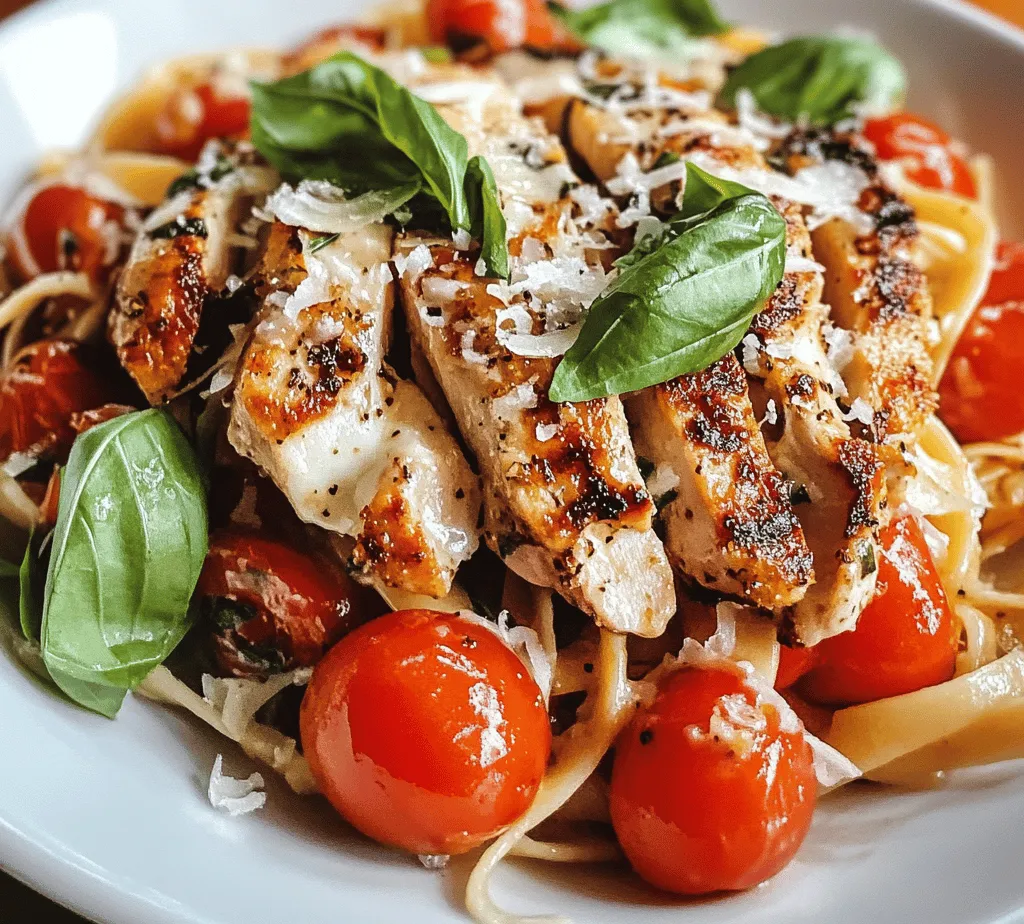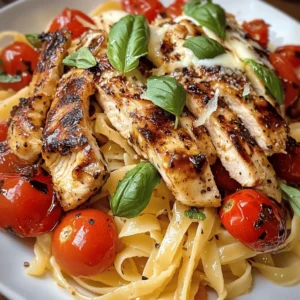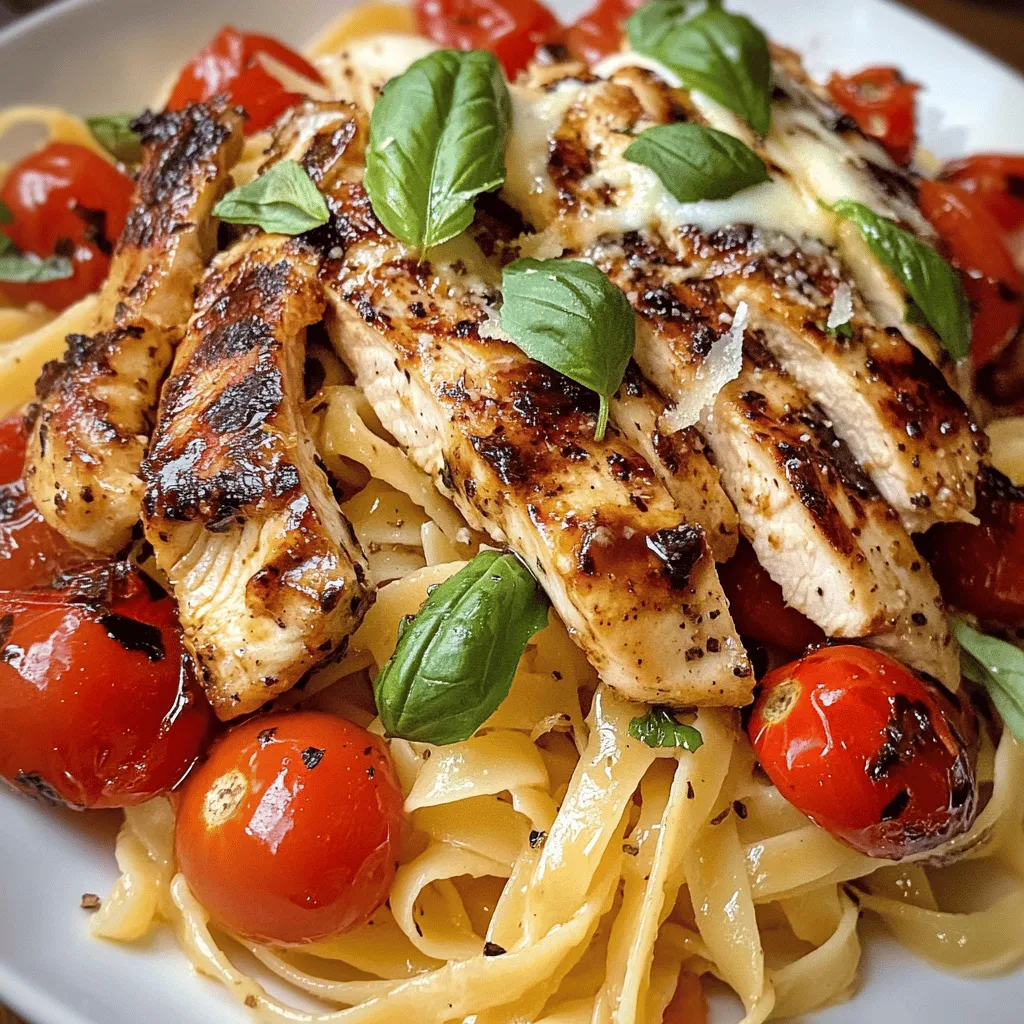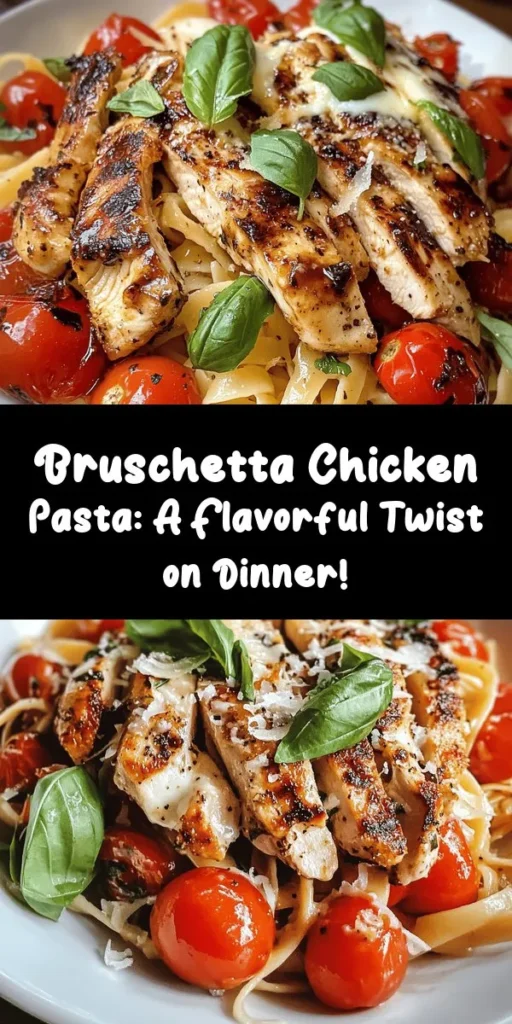Introduction
Bruschetta Chicken Pasta is a delightful dish that unites the classic Italian flavors we know and love with a modern twist that makes it perfect for any dining occasion. With its vibrant colors, robust flavors, and appetizing aroma, this dish is sure to impress both family members on a casual weeknight and guests at a special gathering. The marriage of tender chicken, al dente pasta, and a fresh bruschetta topping creates a symphony of tastes and textures that will have everyone coming back for seconds.
What makes Bruschetta Chicken Pasta so appealing is its versatility. It can be dressed up for an elegant dinner party or kept simple for a cozy family meal. The fresh ingredients used in this dish not only create a stunning presentation but also contribute to its rich flavor profile, making it a go-to recipe for any home cook looking to impress. Whether you are an experienced chef or a novice in the kitchen, this recipe is approachable and easy to follow, ensuring that everyone can enjoy a taste of Italy right at home.
—
Understanding the Ingredients
To create a mouthwatering Bruschetta Chicken Pasta, it’s essential to understand the role of each ingredient in this dish. From protein-packed chicken to the bright acidity of cherry tomatoes, each component plays a critical part in achieving the perfect balance of flavors.
– Chicken Breasts: The star of the dish, chicken breasts provide a lean source of protein that adds heartiness to the meal. When seasoned and cooked properly, they become juicy and flavorful, serving as the perfect canvas for the other elements of the dish.
– Pasta: The type of pasta you choose can significantly impact the overall texture and experience of the dish. While fettuccine offers a silky, flat surface that clings beautifully to the sauce, penne pasta provides a more robust bite with its tubular shape. Both options work well, so feel free to choose based on your preference.
– Cherry Tomatoes: These small, vibrant tomatoes are not only visually appealing but also pack a punch when it comes to flavor. Their natural sweetness and acidity balance the richness of the chicken and the creaminess of the cheese, making them a vital ingredient in the bruschetta topping.
– Fresh Basil: A staple in Italian cuisine, fresh basil adds a fragrant herbal note that elevates the dish. Its bright flavor complements the tomatoes and chicken beautifully, providing a fresh contrast that is essential for a well-rounded dish.
– Balsamic Vinegar and Olive Oil: These two ingredients are key to enhancing the overall flavor profile. Balsamic vinegar adds depth and a hint of sweetness, while high-quality olive oil infuses richness, making each bite more satisfying.
– Mozzarella and Parmesan: These cheeses are responsible for adding creaminess and a savory finish to the dish. Mozzarella melts beautifully, creating a gooey texture, while Parmesan contributes a salty, nutty flavor that ties all the ingredients together.
—
Preparation Steps Explained
Now that we’ve established the importance of each ingredient, let’s dive into the preparation steps that will help you achieve the perfect Bruschetta Chicken Pasta. This process is straightforward, and with a little practice, you’ll be able to whip up this dish in no time.
1. Cooking the Pasta: Start by bringing a large pot of salted water to a boil. The key to great pasta lies in cooking it al dente; this means it should be firm to the bite without being overly soft. Once the water is boiling, add your choice of pasta and cook according to the package instructions, usually around 8-10 minutes. It’s also a good idea to reserve about a cup of pasta water before draining, as this starchy liquid can be used later to help bind the sauce.
2. Preparing the Chicken: While the pasta is cooking, focus on the chicken. Begin by seasoning the chicken breasts generously with salt and pepper on both sides. For added flavor, consider marinating the chicken in olive oil, minced garlic, and herbs for at least 30 minutes if time allows. Heat a skillet over medium-high heat and add a drizzle of olive oil. Once hot, place the chicken breasts in the skillet, cooking for about 6-7 minutes on each side until they are golden brown and cooked through. Use a meat thermometer to ensure they reach an internal temperature of 165°F (75°C).
3. Making the Bruschetta Topping: While the chicken is cooking, you can prepare the bruschetta topping. In a mixing bowl, combine chopped cherry tomatoes, minced garlic, fresh basil, a splash of balsamic vinegar, and a drizzle of olive oil. Season with salt and pepper to taste. Allow the mixture to marinate for a few minutes, which will help the flavors meld together beautifully.
4. Combining Ingredients: Once the chicken is cooked, remove it from the skillet and let it rest for a few minutes before slicing it into bite-sized pieces. In the same skillet, add the drained pasta along with the reserved pasta water and the bruschetta topping. Toss everything together gently over medium heat, allowing the pasta to absorb some of the flavors from the tomatoes and the chicken. Timing is crucial here; you want to combine the ingredients while they’re warm to ensure that the dish remains cohesive and flavorful.
5. Serving Suggestions: For a beautiful presentation, plate the pasta and top it with the sliced chicken. Add a sprinkle of fresh mozzarella and grated Parmesan cheese to finish. Garnish with additional basil leaves for a pop of color. Serve immediately and watch as your guests marvel at the vibrant colors and enticing aroma.
—
This part of the Bruschetta Chicken Pasta recipe sets the stage for a delightful culinary experience, showcasing the fresh ingredients and straightforward preparation steps that make this dish a household favorite. Stay tuned for the next section, where we will explore the nutritional benefits of this delicious meal and how it can fit into a balanced diet.

Nutritional Profile of Bruschetta Chicken Pasta
Bruschetta Chicken Pasta is not only a delightful combination of flavors but also a nourishing meal that packs a nutritional punch. Understanding the health benefits of each ingredient can help you appreciate this dish even more.
Protein Content from Chicken
One of the primary sources of protein in Bruschetta Chicken Pasta comes from the chicken breast. Skinless, boneless chicken breast is an excellent lean protein source, providing around 26 grams of protein per 3-ounce serving. This high protein content is essential for muscle repair, immune function, and overall health. Incorporating chicken into your meals can help you meet your daily protein needs while keeping calorie counts manageable.
Carbohydrates from Pasta for Energy
Pasta serves as the carbohydrate base of this dish, providing the energy needed for daily activities. Choosing whole grain or legume-based pasta can increase fiber content, aiding digestion and promoting a feeling of fullness. A standard serving of pasta contributes approximately 42 grams of carbohydrates, which is vital for fueling your body and maintaining energy levels throughout the day.
Vitamins and Antioxidants from Tomatoes and Basil
The fresh tomatoes and basil used in this recipe are not just for flavor; they also enhance the nutritional profile significantly. Tomatoes are rich in vitamins C and K, potassium, and folate. They also contain lycopene, a powerful antioxidant linked to numerous health benefits, including heart health and reduced cancer risk. Basil, on the other hand, is packed with antioxidants and has anti-inflammatory properties, making it an excellent addition to your diet.
Healthy Fats from Olive Oil
Olive oil plays a crucial role in this dish, both in terms of flavor and health benefits. It contains monounsaturated fats, which are heart-healthy and can help reduce bad cholesterol levels. Additionally, olive oil is rich in antioxidants and anti-inflammatory compounds, contributing to overall wellness. Just a tablespoon of extra virgin olive oil can provide essential fatty acids that are beneficial for brain health and skin vitality.
Variations and Substitutions
Adapting recipes to fit dietary restrictions or preferences can make cooking more inclusive and enjoyable. Here are some suggestions for variations and substitutions for Bruschetta Chicken Pasta:
Gluten-Free Pasta Alternatives
For those who are gluten-sensitive or prefer a gluten-free diet, several pasta alternatives are available. Look for pasta made from rice, quinoa, or chickpeas. These options not only cater to gluten-free needs but usually provide additional nutrients and flavors. Many brands now offer gluten-free pasta that mimics the texture and taste of traditional pasta, making it easy to enjoy this dish without compromising on health or taste.
Chicken Substitutes
If chicken isn’t your protein of choice, there are several substitutes you can use. For a seafood twist, shrimp can be a delicious alternative that cooks quickly and complements the bruschetta flavors beautifully. For a vegetarian option, consider using marinated tofu or tempeh, which can absorb the flavors of the marinade and add texture to the dish. Both options ensure that the meal remains satisfying and nutritious.
Vegan Options
To make Bruschetta Chicken Pasta vegan, simply omit the cheese and chicken, opting for plant-based proteins and nutritional yeast for a cheesy flavor twist. You can also add hearty vegetables like zucchini or mushrooms to enhance the texture and add more nutrients. This way, you can still enjoy the vibrant flavors of bruschetta while adhering to a plant-based diet.
Cultural Significance of Bruschetta and Pasta
Bruschetta and pasta both have rich histories rooted in Italian cuisine, each with its own cultural significance.
Brief History of Bruschetta
Bruschetta originated in central Italy, particularly in Tuscany, and dates back to the 15th century. Traditionally, it consisted of grilled bread rubbed with garlic and topped with a mixture of diced tomatoes, olive oil, and basil. This simple yet flavorful dish reflects the Italian ethos of using fresh, local ingredients to create meals that are both satisfying and wholesome. Bruschetta is often served as an antipasto, showcasing the importance of sharing food within Italian culture.
Evolution of Pasta Dishes
Pasta, on the other hand, has a diverse and ancient history, believed to have been introduced to Italy by Arab traders in the 8th century. Over the centuries, pasta has evolved into a staple of Italian cuisine, with various regional specialties emerging based on local ingredients. The versatility of pasta allows it to be paired with an array of sauces, meats, and vegetables, making it a beloved dish worldwide.
Modern Twist of Combining Bruschetta Flavors with Pasta
The modern twist of combining bruschetta flavors with pasta demonstrates the adaptability of traditional Italian cuisine. This dish captures the essence of both bruschetta and pasta, merging their flavors into a cohesive meal that celebrates freshness and simplicity. By incorporating bruschetta toppings into pasta, home cooks can create a unique dish that honors Italian culinary traditions while offering a contemporary take.
Cooking Tips for Perfect Bruschetta Chicken Pasta
Achieving the perfect Bruschetta Chicken Pasta requires attention to detail and a few cooking techniques to enhance the flavors.
Techniques for Enhancing Flavors
Marinating the chicken is one of the best ways to infuse it with flavor. Consider marinating it in a mixture of olive oil, garlic, balsamic vinegar, and herbs for at least 30 minutes before cooking. This not only enhances the taste but also helps to keep the chicken moist and tender. Additionally, allowing the bruschetta topping to sit for a few minutes after mixing can help the flavors meld together beautifully.
Importance of Fresh Ingredients
Using fresh ingredients is crucial for the best results. Fresh tomatoes, basil, and high-quality olive oil make a significant difference in flavor. When selecting tomatoes, look for ripe, in-season varieties, such as heirloom or vine-ripened tomatoes, which are naturally sweeter and juicier. Fresh basil should be vibrant and fragrant, as dried basil lacks the same intensity of flavor.
Tips for Achieving the Right Pasta Consistency
Cooking pasta to the perfect consistency is essential for a successful dish. Always cook pasta in a large pot of boiling, salted water to ensure even cooking. Aim for ‘al dente’ texture, which means the pasta should be cooked through but still firm to the bite. This texture holds up well when tossed with sauce and other ingredients. Remember to reserve a cup of pasta water before draining; this starchy water can be added back to the sauce to achieve a creamy consistency.
Conclusion
Bruschetta Chicken Pasta is a delightful dish that beautifully blends flavors while offering a range of nutritional benefits. Its versatility allows for numerous adaptations catering to various dietary preferences, making it an inclusive meal option. The rich history of bruschetta and pasta underscores the importance of tradition in Italian cuisine, while the modern twist of combining these elements creates a unique dining experience.
Encouraging readers to try this flavorful dish at home is essential, as cooking with fresh ingredients not only promotes health but also fosters connections with loved ones through shared meals. The joy of cooking and the satisfaction of creating something delicious can be immensely rewarding, inviting everyone to experience the wonderful flavors of Bruschetta Chicken Pasta. So gather your ingredients, embrace your culinary skills, and enjoy this vibrant dish that reflects the best of Italian cuisine.



